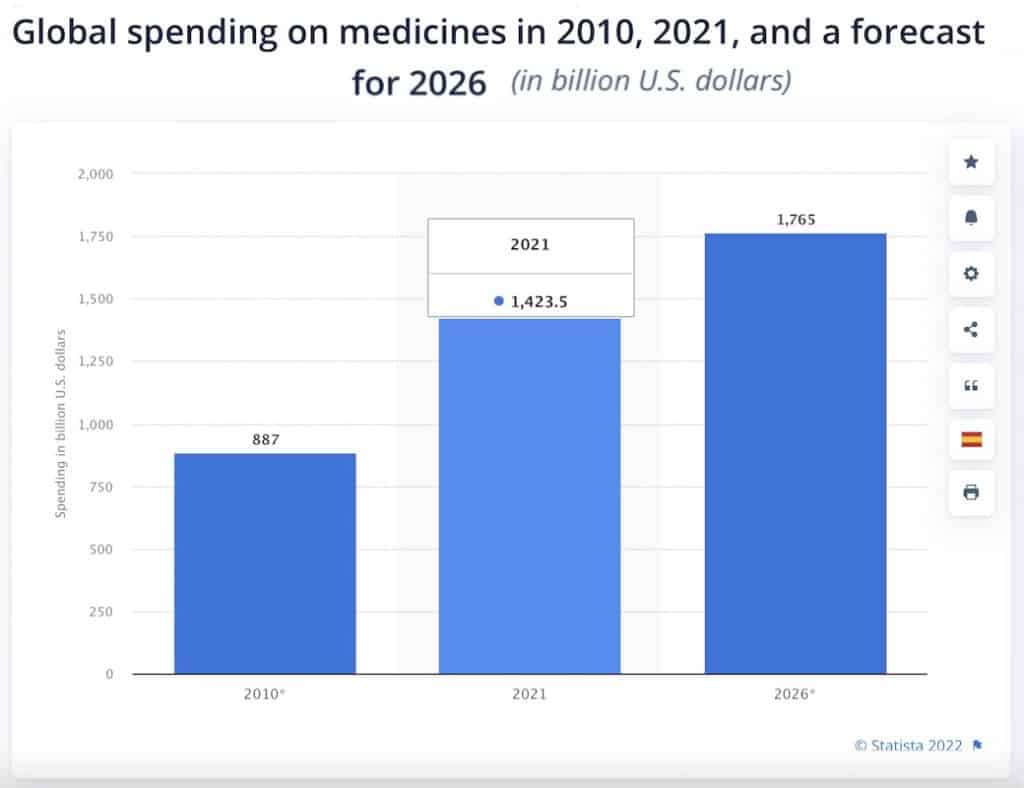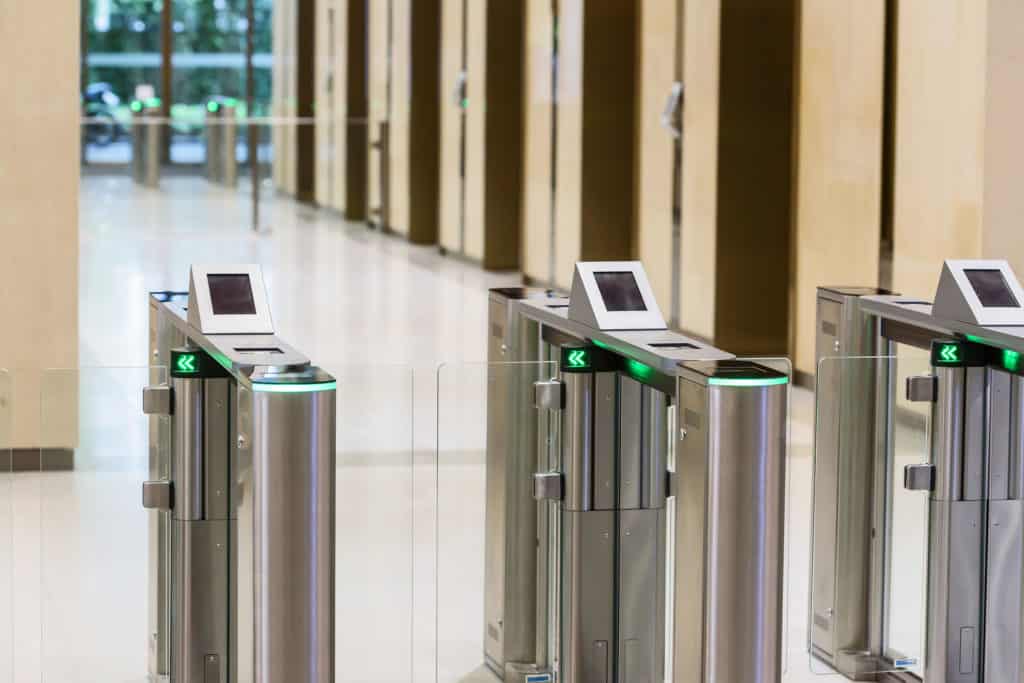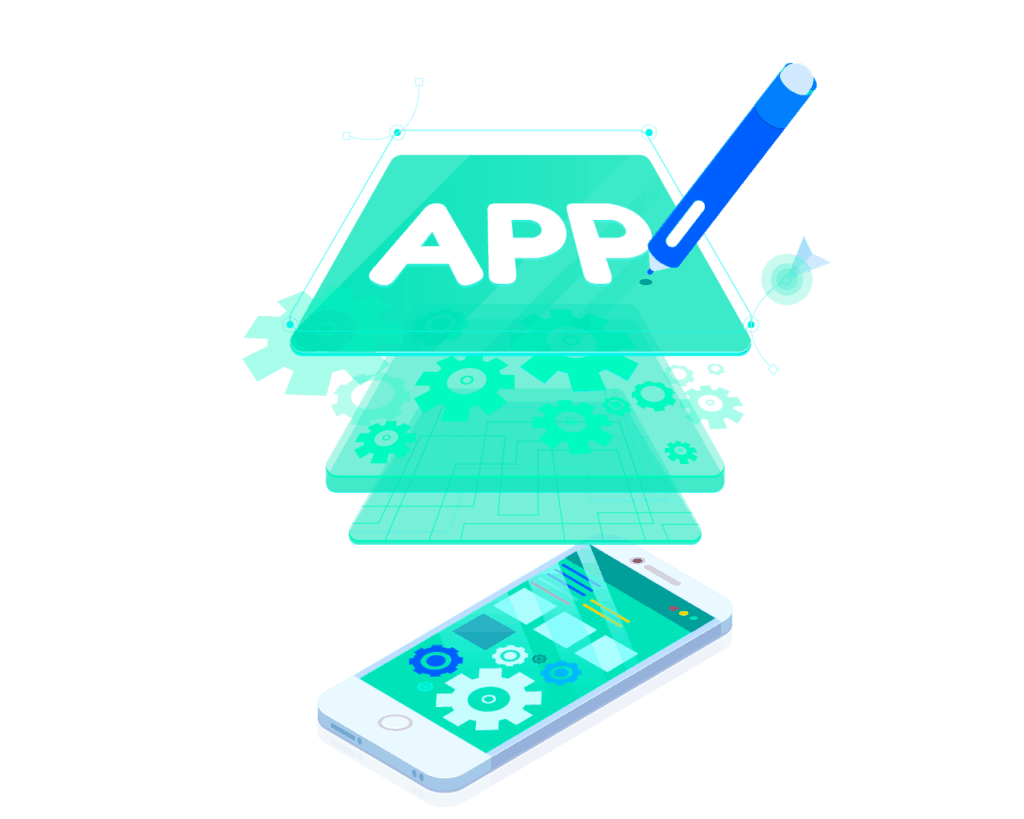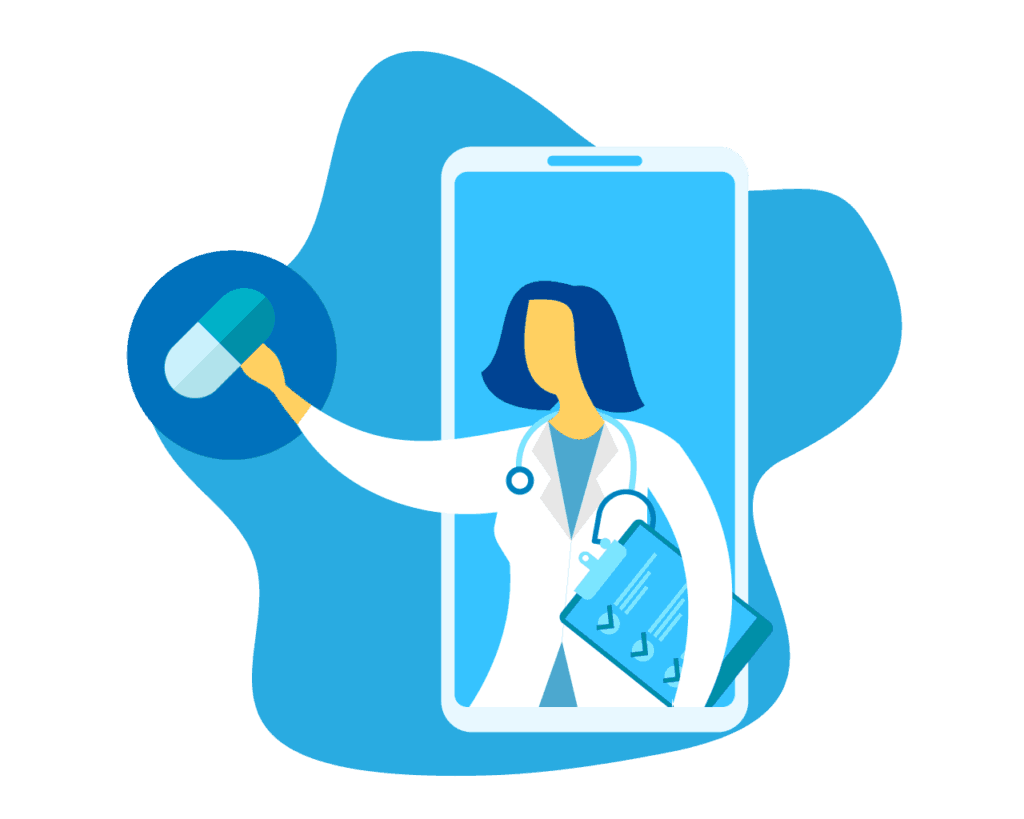On-demand shopping, Netflix, and Uber have transformed our lives forever. The instant gratification trend is so strong that people expect virtually all players in the business-to-consumer economy to follow suit. You can literally buy a lifetime of supplies from your mobile phone without ever leaving the comfort of your home. But there is one market that was, until recently, untouched – the pharmaceuticals.
Big Money, Gaping Opportunity
Every year, more than 4 billion prescriptions are filled in the U.S. alone.
In 2021, Americans spent a whopping $576.9 billion on medicines – approximately 41% of the global market share. A very tall figure when compared to the value of U.S. online retail sales of physical goods which were at $933 billion in the same year.

Image credit: Statista (all rights belong to Statista, Inc.)
Big companies had already started taking notice as of 2018. And in his usual disruptor fashion, Jeff Bezos and his team at Amazon acquired PillPack for $800 million in the middle of 2018 as part of their multi-pronged strategy to enter the online pharmaceutical industry. This was the beginning of a new gold rush, and the sooner you get in the better!
Surprisingly, the regulatory framework also pushes e-Prescribing to the front line: as of January 1, 2023, Medicare Part D participants will have to issue prescriptions for controlled substances using software.
What is an e-Prescription app?
With e-prescription apps, doctors can prescribe any drug wherever they are with just a few taps. These applications include PDMP databases and medication history. In addition, the software can notify about drug-drug, drug-allergy, and drug-diagnosis interaction.
To make healthcare professionals’ lives even easier, an e-prescription app may also display additional info, for example, out-of-pocket costs for any drugs based on the patient’s insurance. And a semi-automated order refill option further simplifies doctors’ routine.
Here’s a list of typical features of e-presciption mobile software:
- prescription filling
- order refills
- real-time updates
- secure authentication
- patient prescription history
- drug and allergy interactions checks
- appointment scheduling
- EHR and billing integrations
Who needs an e-prescription app?
E-prescription software is primarily designed for doctors and pharmacists. However, you can extend your offering by building a dedicated mobile app for patients or update an existing patient app for them to track their orders.
By the way, since e-prescribing apps singnificantly augment doctor’s and pharmacists’ workflow, you may want to consider adding a chat option to open a direct line of communication between the involved parties.
How does e-Prescribing work?
Electronic Prescribing or e-prescribing simplifies communication between the care provider and the pharmacy. Because of this, more accurate prescriptions are given and common sources of medication errors are eliminated. The doctor creates and sends prescriptions electronically and they are automatically pushed into the pharmacy’s system for processing and fulfillment.
e-Prescribing removes the need for paperwork and transportation of documents. It also creates a secure feedback loop where both the doctor and pharmacist can communicate instantly; speeding up service delivery and improving patient health outcomes. Surescripts reported 31.44 million clinical direct messages between care providers in 2018 at critical stages of patient care.
What are the benefits of e-prescription?
Many complications and failures in patient care result from poor drug management. When a medication becomes unavailable or a paper prescription cannot be read because of bad handwriting or if it goes missing, it takes a lot of going back and forth to rectify.
Without e-prescribing, communication between the pharmacist and the physician is usually limited to the phone and fax. This is very inefficient.
The patient stays in limbo as the two parties negotiate the amendments to the prescription. This can lead to missed doses, overdoses or even adverse drug interactions. All these can create health complications or lead to the death of the patient.
You can literally save lives with your e prescription app. To put it succintly, e-prescription:
- Saves time
- Improves health outcomes
- Improves adherence to medication
- Eliminates manual processes
- Enhances patient safety
- Helps to monitor controlled substances
How to overcome barriers to entry and regulatory hurdles for e-Prescribing?

Can you build your e-prescription app from scratch?
Yes. But you’d need to be certified by Surescripts and you need to be integrated into their network. The process takes several months, has very stringent requirements and will set you back a cool $3000. It’s like wanting to build your own road network for your new car. Highly impractical to say the least. Not only would you build the infrastructure but also need the resources to maintain it.
Read more on Surescript integration in our blog
The Surescripts Network Alliance is the nation’s gatekeeper for e-prescription. It connects “virtually all EHRs, PBMs, pharmacies, and clinicians, plus an increasing number of health plans, long-term and post-acute care organizations and specialty pharmacy organizations.”
Surescripts powers approximately 85% of all prescriptions in the country. 79% of the U.S. population’s benefit information is hosted on their network. Their expansive directory includes 1.61 million providers, along with 258 million patients.
Fortunately, you don’t need to start from scratch. There’re several plug-and-play solutions already available on the market that are certified. You can buy any of these off-the-shelf tools and integrate them into your mHealth app. With this rapid-fire approach, you can build your own e-prescription app in just weeks as opposed to months and possibly years.
Related: The Ultimate Guide to Building The Best mHealth Apps in 2019
Plug and play e-prescription solutions

While there are several eRX solutions available, I’m sticking to just the ones you can integrate into your app. I will not be discussing those which function as whitelabel standalone apps such as DrChrono. There’s a couple of those but because they are designed to work as standalone apps, you can’t integrate them into your existing EHR or other mHealth apps.
Truepill
Truepill is the pharmaceutical industry’s white label dropshipping service. This API creates a link between the pharmacy and the customer. It’s based on a fulfillment model. It receives e-prescriptions (eRX) and sends them to Truepill for fulfillment.
You can integrate Truepill’s API into your telemedicine website or healthcare mobile app. Their pricing mechanism is based on a negotiated service fee per transaction.
The RESTful API is exposed as HTTP endpoints that return JSON data. Endpoints include:
- Authentication,
- Fill Requests
- Transfer prescription
- Direct Transfer Prescription
- Insurance
- Copay Request
- Create Copay Request
- Patient
- Customer
- Callback/Webhook Overview
- Callback/Webhooks Endpoints
- Return Prescription
Truepill’s API is highly customizable. You can utilize all or just some of the functions and still have a great app. HIMs, HERs, Nurx, Apostrophe & Lemonade are all powered by Truepill.
Case Study
GoodRx uses Truepill as a mail delivery pharmacy partner, fully accredited by URAC and NABP and committed to protecting patient confidentiality. The app allows members to transfer prescriptions right inside the app from a brick-and-mortar pharmacy to Truepill’s mail order service.
If you are looking to build an app for a pharmacy that will fulfill prescriptions online, this is the Amazon Web Services of online pharmacies. If you are a doctor looking to have an eRx app, this is not the API for you.
Dosespot
Dosespot integrates fully into your app. You can utilize their Surescripts & EPCS certified e-Prescribing user interface in your own app. Built for sprint development, the onboarding process is swift and you can roll out in a matter of days.
It’s absolutely customizable so you can change the look and feel of the Dosespot interface to match your branding. They provide editor access to their CSS file so you can change the colors, fonts, font sizes, and more.
The price is not exorbitant. Their pricing structure is based on the number of send-outs. For $525/month, you can send up to 500 prescriptions. Instead of having a separate integration fee, the cost is built right into the monthly charges. Considering the cost per patient visit, this price is not too bad – just a little over a $1 per prescription.
The best takeaway from Dosespot is that once they approve your app, you are automatically qualified to be listed on the Surescripts.com website as a certified solution. As as far as we can tell, they’re the only ones offering this. It goes without saying that this is probably the reason behind their large customer base.
Case Study
Doctor On Demand integrated Dosepot’s e-prescribing service into its telehealth applications to write prescriptions where clinically appropriate right from smartphones and tablets. Using Dosepot APIs, Doctor On Demand physicians can:
- send e-prescriptions to 65,000+ pharmacies nationwide
- get alerts for dangerous medicine interaction
- accumulate prescription history data from community pharmacies, patients, payers and pharmacy benefit managers
- request info about insurance eligibility when prescribing
MDtoolbox
This is a cloud-based e-prescribing solution. It can be integrated into the app or used as a standalone turnkey solution.
Features include:
- One-Click Refills
- One-Click New Rx Writing
- Favorites Lists for your provider’s commonly used drugs
- e-Refill
- Search function for drugs (variables are name, nickname, generic, brand, rx, OTC, class or indication)
- e-Cancel to electronically send prescription cancellations to pharmacies.
- EPCS Certified: you can e-prescribe controlled substances
- Real-time message sending with immediate responses from pharmacies
Maven, Softech, and DgMed are just a few examples of companies that run on MDtoolbox. This is a solid platform.
The case for prebuilt solutions
This is a relatively new space in the mHealth sector. Just like Stripe and Plaid have embedded themselves into a very vital value-chain in the financial sector, these eRx solutions are powering the future of pharmacy operations.
Also Read: Healthcare App Development Guide
As such, the creators of these solutions are in for the long run. They viciously and ambitiously invest into their platforms. Technical support, training and other vital functions you’d need to provide if you were running an inhouse solution, are taken off your shoulders.
The other value aspect is the scalability they offer. You can easily scale to provide services to the whole country with just a few changes in configuration.
Finally, they are not looking to compete with you. They are just enablers. And that right there is something worth noting.
Get started
Do you have an e-prescription project that you need help with? Sometimes you just need to talk to an expert and bounce off a few ideas or discuss specifics around feasibility and app development costs. Schedule a consultation with our healthcare app developers to bring your app idea to life.
Related Articles:
- How to create a telehealth application
- Guide to creating a medication reminder application
- EHR/EMR App Development Guide
- Hospital Management System Development
- How to build a doctor appointment application
- How to create a pharmacy application
- HIPAA Compliant App Development
- Guide to healthcare mobile app design
[This blog was originally published in September 2019, and has been updated for more recent data]

